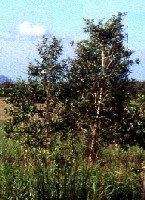| BRIEF DESCRIPTION A shrub or a medium-sized to tall tree reaching 25-40 m in height. It usually has a single stem with layered and papery bark. USES The leaves and the terminal branchlets are the source of the medicinal Cajeput oil. The wood can be used as fuel, it is durable in contact with salt or fresh water and can be used for posts and poles. The soft park can be utilized for fibre-board, paper, and packing material. The tree is a good ornamental, it can provide shade and shelter and is a source of honey. GROWING PERIOD Moderately fast-growing perennial. COMMON NAMES Swamp tea-tree, Paperbark tea-tree, Cajput tree, Kayaputih. FURTHER INF Swamp tea-tree occurs in northern Australia within the latitudinal range 10-18°S at elevations between sea level to 200 m. It is mainly found along drainage lines or in low, swampy coastal plains, but it can also occur on dry, rocky soils. It is a potential weed in some environments. (pH estimated by the compiler). |
SOURCES (Melaleuca cajuputi Powell. )
Turnbull J 1986 pp 276-277 [TEMP, KTMP, RAIN, TEXT, DRA, DEP, FER, USE, LIMIT] |
